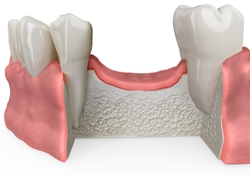Jaw grafting
 Oral bones recede due to two main reasons: inflammation around roots and extraction of a tooth.
Oral bones recede due to two main reasons: inflammation around roots and extraction of a tooth.
After extraction of a tooth, a small area of bone located right at the root always recedes. The reason for that is that periodontium ligaments are torn out of it and the bone loses its function. It is an inevitable bone rearrangement. The primary recession of the bone lasts from one and a half to two months after extraction of a tooth. The bone heals for several other months. After that, a secondary recession of the bone starts because this part of the jaw bone is no longer under the load. If the bone is not stimulated, it deteriorates. Therefore, it is extremely important not to wait for longer than several months after extraction of a tooth and perform implantation in due time. 
An implant like a natural root must be surrounded by bone on all sides. Therefore, when the bone has receded, it is grafted. Own or special artificial bone can be used for this purpose. Own bone is usually taken from the same place where an implant will be placed or it is transplanted from other areas of the mouth. Very occasionally, in case of a complete deterioration of oral bone (after severe traumas, oncological surgeries), it is taken from a rib or pelvis.
When only some bone is lacking, grafting is performed along with implantation. Correction of a more serious defect of the jaw bone requires a separate procedure.
Bone is usually insufficient in the area of pre-molars and molars of the upper jaw. In this case, the surgery during which the sinus membrane (mucosa) lining of the upper jaw is lifted is performed. The sinus is an airy cavity within a bone connected with the nose and located above dental roots and below eye-sockets which is lines with a membrane. During the sinus lift surgery, the sinus membrane is pushed away from the bone which used to support teeth, and a gap produced between the bone and the membrane is filled with artificial bone. Thus, the height of bones is increased for dental implants.

In the area of incisors, bone grafting and gingival grafting are usually performed because this area is clearly visible and maximum restoration of naturalness of teeth and gums is required.
Modern bone grafting procedures are very successful provided one condition is met, i.e. the patient’s body has a basic capability to heal which is determined by the overall condition of the body. After any surgery performed in our Clinic, all patients are provided with the Guidelines on how to take care of the oral cavity, what to eat, what phenomena after the treatment are normal, and in what cases a patient should see the doctor without any delay.
specialists Contacts Doctor's appointment


